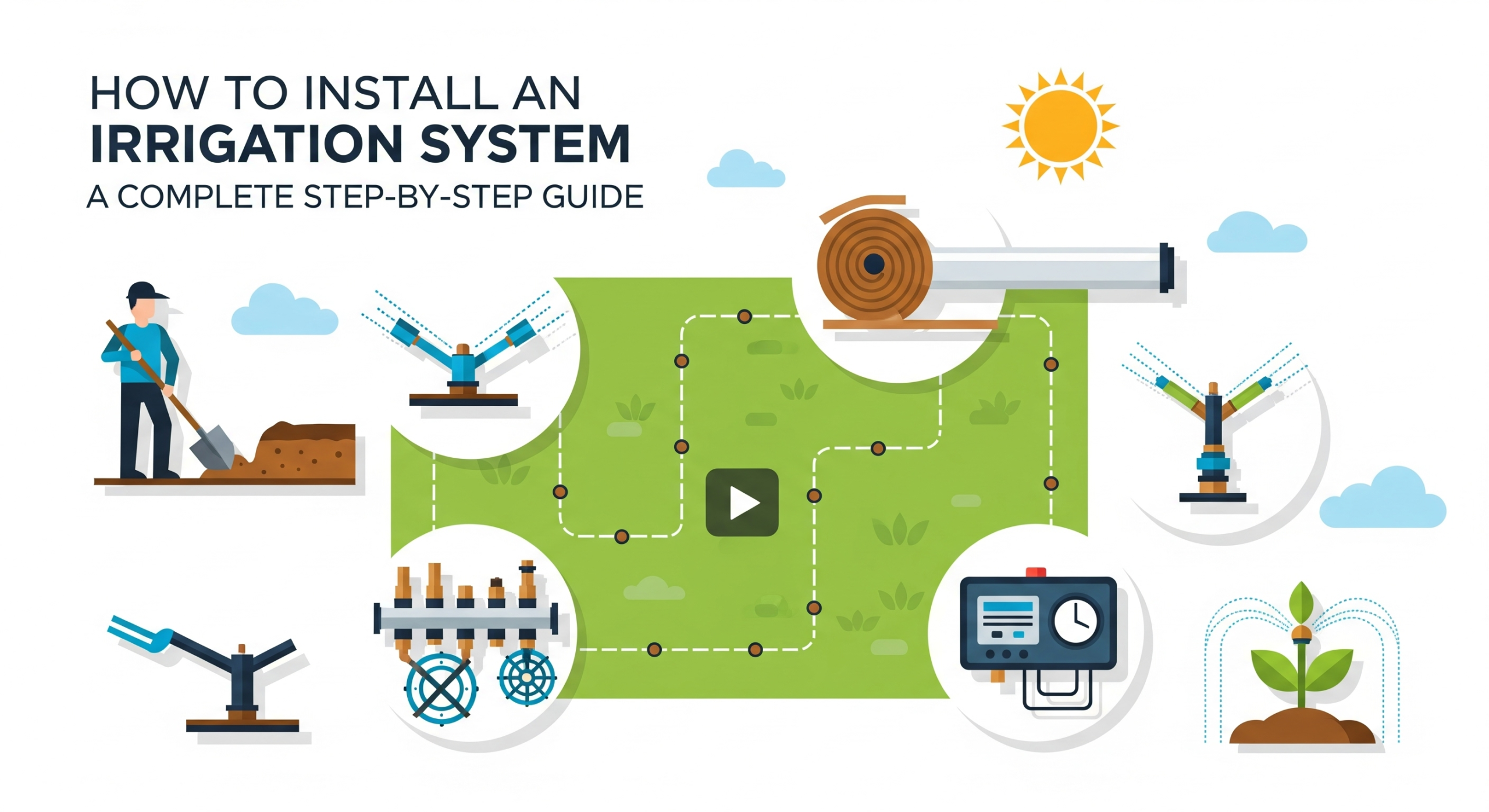How to Install Irrigation System: A Complete Step-by-Step Guide

If you’re wondering how to install irrigation system in your garden or lawn, you’re in the right place! An efficient irrigation system is essential for maintaining healthy plants, conserving water, and saving you time during watering routines. This comprehensive guide will cover everything from understanding what irrigation is to planning your system setup, and finally to detailed installation steps, including valuable tips and maintenance advice. Let’s get started!
Key Takeaways
- A well-installed irrigation system saves water and improves plant health.
- Different types of systems cater to various needs — choose wisely.
- Planning is essential to avoid common pitfalls like uneven watering.
- Regular maintenance extends the life and efficiency of your system.
What is Irrigation?
Irrigation is the artificial application of water to soil or plants to assist in their growth and maintain beautiful landscapes. It plays a crucial role in both agriculture and landscaping, especially during dry periods when natural rainfall is scarce.
Types of Irrigation Systems
There are three common types of irrigation systems, each serving different needs:
- Sprinkler Systems: These systems distribute water over large areas, making them ideal for lawns and larger garden beds. They simulate natural rainfall, ensuring plants receive adequate hydration.
- Drip Irrigation: With this method, water is delivered directly to the roots of plants, minimizing waste. It’s particularly beneficial for vegetable gardens and flower beds, controlling the amount of water each plant receives.
- Soaker Hoses: These are flexible hoses that release water along their length. They’re perfect for narrow beds or vegetable rows, allowing slow, efficient watering.
Benefits of a Well-Installed Irrigation System
Having a properly installed irrigation system offers numerous benefits, such as:
- Water Conservation: Efficient systems save water by delivering it exactly where it’s needed.
- Time Savings: Automated systems reduce the time spent manually watering your garden.
- Improved Plant Health: Consistent watering leads to healthier plants and a more vibrant landscape.
- Maximized Landscape Potential: Well-maintained gardens flourish more effectively with the right irrigation setup.
Planning Your Irrigation System Setup
Before diving into installation, it’s essential to plan your irrigation system carefully. Follow these steps to ensure an effective setup:
Assess Your Garden or Lawn’s Needs
- Measure Size and Shape: Knowing the dimensions of your area helps determine how much pipe you’ll need and where to place your sprinklers or drip lines. For more detailed measurement techniques, refer to How to Read a Measuring Tape.
- Identify Plant Types: Different plants have varying water requirements, so take note of what you’re growing.
- Note Site Conditions: Pay attention to slopes, shaded zones, or areas prone to dryness, as these factors influence watering needs.
Choose the Right System Type
Decide whether a sprinkler, drip, or soaker hose system is best for your landscape. For expansive lawns, a sprinkler system may be ideal, while drip systems work wonderfully for vegetable gardens. If you’re considering integrating artificial elements, you might also explore How to Install Artificial Grass.
Create a Layout Plan
- Mark Key Points: Use stakes, string, or paint to identify where each sprinkler head or drip emitter will be placed, ensuring adequate coverage overlap.
- Plan for Pipe Routes: Layout where the main lines and valves will go, keeping logical zones for efficient watering.
Importance of Planning
Taking the time to plan your irrigation setup prevents uneven watering and water wastage.
Step-by-Step Guide on How to Install Irrigation System
Gathering Necessary Tools and Materials
Before beginning your installation, gather the following tools and materials:
- Shovel or Trenching Tool: To dig trenches for your pipes.
- PVC or Polyethylene Pipes: These will carry water throughout your system.
- Fittings and Connectors: Necessary for joining pipes and fastenings.
- Sprinkler Heads or Drip Emitters: Your system’s watering components.
- Valves: One valve per zone to control water flow.
- Pipe Cutter: For cutting pipes to the desired length.
- PVC Primer and Cement: Essential for PVC systems.
- Stakes and Flags: Used to mark your layout.
- Controller or Timer (Optional): For automating your watering schedules.
Preparing the Installation Area
- Clear the Area: Remove debris, grass, and stones to prepare for digging.
- Mark Pipe Routes: Clearly indicate where the pipes will run and where each sprinkler or emitter will be installed.
- Locate Underground Utility Lines: Call your utility company to mark any underground lines before starting your digging.
- Dig Trenches: Create trenches 6 to 12 inches deep, depending on your region’s climate and frost line requirements.
Installing Main Lines and Valves
- Start at the Water Source: Begin your installation near the manifold or main water line.
- Cut and Lay Pipes: Use your pipe cutter to cut pipes to the required lengths.
- Join Pipes: Use fittings to connect pieces; if using PVC, be sure to apply primer and cement.
- Place Zone Valves: Install one valve per zone to control water flow effectively.
- Seal Connections: Ensure all joints are properly sealed to avoid leaks.
Setting Up Sprinklers or Drip Lines
- Attach Risers: For sprinkler systems, screw heads onto risers.
- Insert Drip Emitters: For drip irrigation, punch holes in your tubing and insert the emitters according to your design.
- Adjust for Coverage: Position and adjust the sprinklers or emitters to ensure full coverage of the intended areas.
To further understand setting up sprinklers and drip lines, watch helpful instructions on YouTube here.
Connecting to the Water Source
- Shut Off House Main Water Supply: Ensure no water is running during installation.
- Tap the Main Water Line: Use a tee fitting to create a connection to the irrigation system’s main line.
- Install a Backflow Preventer: This is essential to protect your home’s water supply from contamination.
- Set Up Controller or Timer: Connect a controller or timer for automated watering if desired.
Testing the System
- Turn On Water Supply: Slowly switch on the water and check for leaks.
- Test Each Zone: Inspect each watering zone individually to ensure even coverage.
- Flush the System: Flush lines before installing final sprinkler heads to clear debris.
- Adjust as Needed: Fix any leaks or adjustments necessary for optimal performance.
Tips for Effective Irrigation System Setup
- Design for Even Distribution: Plan your layout to prevent overwatering or creating dry spots.
- Invest in Automation: Use timers or smart irrigation controllers to make your watering plans more efficient.
- Adjust Seasonally: Modify your watering schedules according to changes in weather and plant needs.
- Choose Quality Materials: Using robust components will improve durability and reduce future maintenance.
Maintenance and Troubleshooting
Regular maintenance of your irrigation system is crucial for long-term success:
- Inspect Regularly: Keep an eye out for leaks, clogs, and misalignment of sprinkler heads or emitters.
- Clean Filters: Regularly clean filter screens and replace any faulty parts.
- Winterize Systems: If you live in a colder climate, ensure you drain and blow out your system’s lines before frost sets in.
- Troubleshoot Common Issues: Know how to handle electrical issues with timers/valves or fix pipe breaks and clogged emitters.
Conclusion
In summary, understanding irrigation, planning your system setup, accurately installing the components, and performing regular maintenance are key steps in successfully learning how to install irrigation system. A well-installed irrigation system doesn’t just save water; it also promotes healthier plants and enhances the beauty of your landscape. Don’t hesitate to start your irrigation installation project today for a thriving garden or lawn!
For further reading on installation and system maintenance, visit Rain Bird’s installation guide here, This Old House’s article here.
Additionally, you might find How to Lay Sod helpful when preparing your lawn area, and How Long Does Caulk Take to Dry can provide valuable information during the sealing process. For more installation projects, refer to How to Install Artificial Grass.






